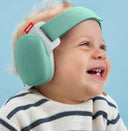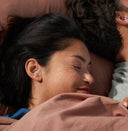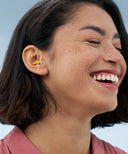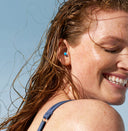Flying for the first time with your baby? That can be really stressful. But with proper preparation, travelling with a little one is perfectly manageable. From the time your baby can fly to what you need to take with you; we've listed it all. And did you know that babies' hearing is extra sensitive? Sounds on an airplane can be overwhelming. Hearing protection not only helps with loud noises, but also prevents overstimulation and makes it easier to take a nap on the way. In this blog, you will find more practical tips as well as smart hacks to make travelling by air with a baby as relaxed as possible. Ready for take-off? Fasten your seatbelts! Enjoy your holiday, but also the journey.
Preparing for a flight with your baby
Flying with a baby requires just a little more preparation than travelling solo with a backpack. But don't worry: with the right preparation and a few handy tips, it will be a smooth ride. You can read everything you need to know here, before boarding the plane with your little one. Let's start with some frequently asked questions and answers about flying with a baby:
-
From what age may you fly with a baby?
In theory, your baby may board a plane just a few days after birth, but most airlines set a minimum age of 1 to 2 weeks. For both baby and parents, it may be wise to wait a little longer. In the first few weeks, you are often getting used to a new rhythm (or lack thereof), and a plane journey can then be extra challenging. Also for your own health and recovery from childbirth, it is good to decide for yourself whether you are already comfortable flying with your baby. Always check the airline's terms and conditions and consult your GP if in doubt.
-
Does my baby need their own passport when flying?
Yes, even the smallest babies need their own passport or identity card. Including them in mum or dad's passport is unfortunately no longer possible. A cute passport photo showing your baby looking up and smiling is not allowed. Passport photo rules are strict, so getting a good passport photo of your baby can be a challenge. Fortunately, most photographers know a few tricks of the trade to get the best end result. So, have the passport photo of your baby taken by an official photographer in your area.
-
Do you have to book a plane ticket for a baby or do they travel for free?
Good news: many airlines allow babies up to the age of 2 to travel on your lap for free or for a small fee. You usually only pay taxes and surcharges if you fly with a child under the age of 2. Would you rather your baby had their own seat while flying? That's possible, but then you often pay full price. Bringing a car seat for extra comfort is recommended in that case. Check in advance if it is approved for use on a plane and if it is permitted by the airline.
-
How much extra hand luggage may you take for the little one?
Each airline has its own rules for this, but often you are allowed to bring an extra piece of cabin luggage, such as a nappy bag, for your baby. This will come in handy because you have to take a lot with you when you travel with a baby. In addition to the usual contents of your nappy bag, don't forget something to protect sensitive ears from the noise during take-off and landing, as well as to muffle ambient noise at the busy airport. In terms of hand luggage, we recommend checking carefully in advance how much you're allowed to take, so you don't get any nasty surprises.
-
Can you bring food for your baby on the plane?
Yes, you can simply carry your baby food in your hand luggage. Even if it is more than the standard 100 ml. Bottle-feeding formula, breast milk and jars of baby food are allowed to pass through customs. But do show what you are bringing. Need hot water? At many airports and on airplanes, you can ask for boiled water to warm a bottle or jar. Tip: check the airport rules again shortly before departure. They can sometimes change.
-
Is there a cot available on the plane?
On long flights, you can often reserve a cot (bassinet). This is a godsend for getting your baby to sleep well while flying and you then have your hands free too. Please note that there are only a limited number of these cots available and they are often attached to a specific row of seats. So early reservation is recommended.
Tips for your hand luggage when flying with a baby
Good preparation is half the battle when flying with a baby. And that certainly applies to your hand luggage. Make sure to bring a well-stocked nappy bag. Something that is indispensable when flying with a baby is
- More than enough nappies
- Baby wipes
- Extra sets of clothing
- Plastic bag (for clothing mishaps)
- Bottle feeding or breastfeeding accessories
- Hydrophilic nappies
- Blanket
- Pacifier (plus a spare)
- Toy(s) for distraction
- Hearing protection
Airplane noise can be quite intense for little ears, especially during take-off and landing. Over-stimulation can also be an issue at the airport. With special baby headphones, you can avoid unnecessary inconvenience. So be sure to bring these in your hand luggage. This will make the journey a little more relaxing for everyone.
Five tips for a smooth plane journey with your baby
Are you now convinced that flying with a baby is actually possible? Now read our best tips for a smooth flight for both you and your little one.
Tip 1: Plan well and choose your flight time
If possible, choose a flight that matches your baby's sleep pattern. A night flight or travelling during afternoon nap time can help keep your baby calm and comfortable for as long as possible. Flying early in the morning or late in the evening can also be convenient, as it is often quieter at the airport and on the plane.
Tip 2: Make sure your hand luggage is well packed
Smart hand luggage is your salvation. Make sure you have nappies, baby wipes, extra clothes, food and some favourite toys. Also consider a blanket, pacifier for extra comfort and little surprises. A new toy or a snack that your baby likes can provide just that little bit of distraction at the right time.
Tip 3: Protect your baby's ears
During take-off and landing, the pressure differences on the plane can irritate your baby. You can alleviate this by getting your baby to drink (at the breast, from a bottle or with a pacifier). The ambient noise on an airplane can be overwhelming. Not only on the plane do you have unexpected and unfamiliar noises, but the airport can be rowdy too. Hearing protection, such as the Alpine Muffy Baby, helps to muffle loud noises and your baby to travel more peacefully.
The Alpine Muffy Baby earmuffs are ideal for protecting babies' hearing from a variety of noises. The soft, adjustable headband is designed to prevent pressure on the baby's fontanel. The earmuffs prevent overstimulation from airport and airplane noise. Your baby can then rest undisturbed while travelling. A relaxed baby = a relaxed flight.
Tip 4: Move around and take advantage of extra options
Many airlines offer cots (bassinets) on long flights. Ask about this when booking your flight. During the flight, it can help to occasionally get up and walk around with your baby if they become restless. Movement not only helps them to relax, but also relieves ear pain caused by changes in air pressure.
Tip 5: Stay relaxed and embrace the chaos
A crying baby on a plane? It happens. And it's okay: don't stress, it's perfectly normal. Try to stay as relaxed as possible yourself, because babies can sense when you are stressed. Most fellow passengers are understanding (or have headphones) in such situations. The calmer you stay, the more likely it is that your baby will be easier to console. Hearing protection for a baby on the plane can make them more relaxed and cry less.
Bonus tip: Check in on time
To make your air travel with a baby or child go smoothly, it is wise to check in well in advance. This can often be done 24 hours before the journey. This means you spend less time waiting at the check-in desk and you will get through customs faster.
With proper preparation and a healthy dose of flexibility, your air travel with a baby will be an experience you can look back on with a smile. And who knows? Maybe your little one will take to air travel like a pro.
This article is for informational purposes only and does not replace medical advice. Have questions about your health? Contact a doctor or healthcare professional.




